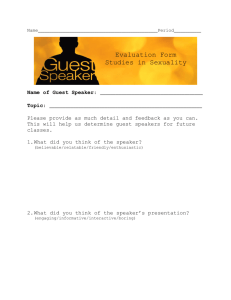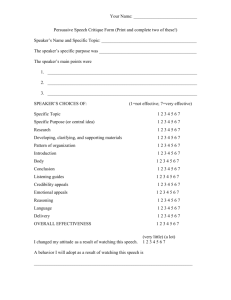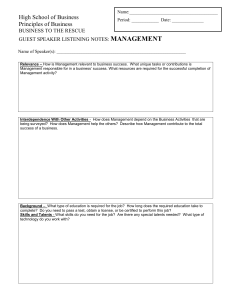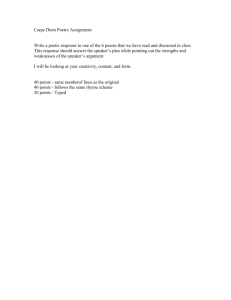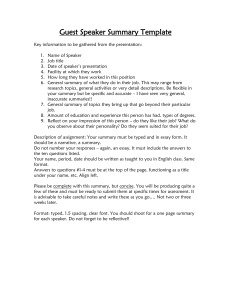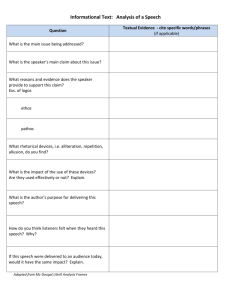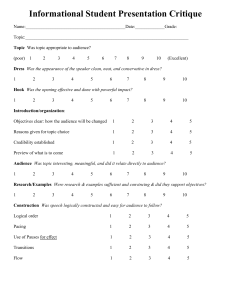G Cultural Diversity
advertisement
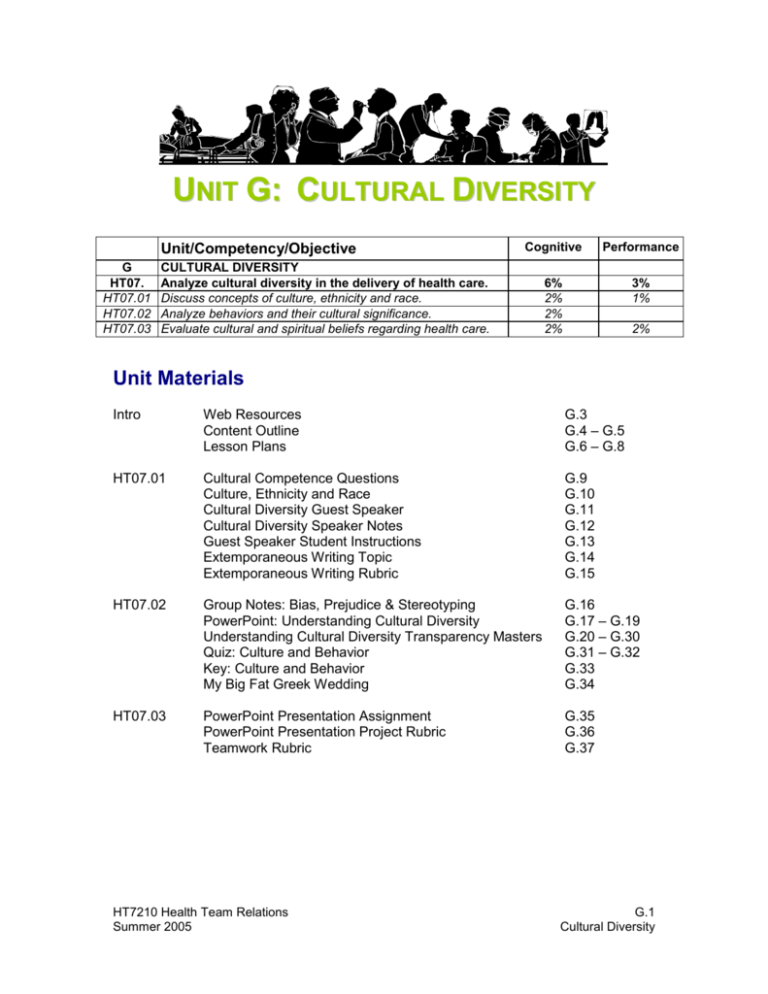
UNIT G: CULTURAL DIVERSITY Unit/Competency/Objective G HT07. HT07.01 HT07.02 HT07.03 Cognitive Performance 6% 2% 2% 2% 3% 1% CULTURAL DIVERSITY Analyze cultural diversity in the delivery of health care. Discuss concepts of culture, ethnicity and race. Analyze behaviors and their cultural significance. Evaluate cultural and spiritual beliefs regarding health care. 2% Unit Materials Intro Web Resources Content Outline Lesson Plans G.3 G.4 – G.5 G.6 – G.8 HT07.01 Cultural Competence Questions Culture, Ethnicity and Race Cultural Diversity Guest Speaker Cultural Diversity Speaker Notes Guest Speaker Student Instructions Extemporaneous Writing Topic Extemporaneous Writing Rubric G.9 G.10 G.11 G.12 G.13 G.14 G.15 HT07.02 Group Notes: Bias, Prejudice & Stereotyping PowerPoint: Understanding Cultural Diversity Understanding Cultural Diversity Transparency Masters Quiz: Culture and Behavior Key: Culture and Behavior My Big Fat Greek Wedding G.16 G.17 – G.19 G.20 – G.30 G.31 – G.32 G.33 G.34 HT07.03 PowerPoint Presentation Assignment PowerPoint Presentation Project Rubric Teamwork Rubric G.35 G.36 G.37 HT7210 Health Team Relations Summer 2005 G.1 Cultural Diversity Recommended Resources First Edition Author: Louise Simmers ISBN #: 1401858090 ©2004 Publish Date: 1/5/2004 Binding: Hardcover Pages: 340 Publisher: Delmar Learning Supplemental Resources Third Edition Author: Geri-Ann Galanti ISBN #: 0812218574 ©2003 Publish Date: 11/1/2003 Binding: Paperback Pages: 256 Publisher: University of Pennsylvania Press This book contains a rich resource for this unit by providing multiple examples of patient and health provider interaction. It was on the HOSA Medical Reading list in 1999-2000. HT7210 Health Team Relations Summer 2005 G.2 Cultural Diversity Web Resources http://www.diversityrx.org Diversity Rx is a clearinghouse of information on how to meet the language and cultural needs of minorities, immigrants, refugees and other diverse populations seeking health care. Here you'll find answers to questions like: how do language and culture impact the way clients use health services who has developed model programs, best practices, training courses, and quality assessments what do civil rights law and other laws say should be done to provide equal access to health care services what's the role of linguistically and culturally appropriate services in assuring quality, improving cost-effectiveness, and responding to managed care regulations and accreditation guidelines? http://www.omhrc.gov/cultural/ The Office of Minority Health was mandated by the United States Congress in 1994 to develop the capacity of health care professionals to address the cultural and linguistic barriers to health care delivery and increase access to health care for limited English-proficient people. Additionally this mandate directs OMH to support research, demonstrations, and evaluations to test new and innovative models aimed at increasing knowledge and providing a clearer understanding of health risk factors and successful prevention intervention strategies for minority populations. The Center for Linguistic and Cultural Competence in Health Care (CLCCHC) was established in FY 1995 as a vehicle to address the health needs of populations who speak limited English. This website includes the National standards for culturally and linquistically appropriate services in health care. Center for the Study of Cultural Diversity in Health Care http://www.med.wisc.edu/cdh/ The fundamental Mission of the Center for the Study of Cultural Diversity in Healthcare (CDH) at the University of Wisconsin Medical School is to facilitate the design, implementation, evaluation and replication of culturally and linguistically competent healthcare programs to improve consumer satisfaction and health outcomes for all residents of Wisconsin. HT7210 Health Team Relations Summer 2005 G.3 Cultural Diversity Content Outline Unit G Cultural Diversity HT07.01 Discuss concepts of ethnicity, culture and race. A. Concept of individual’s uniqueness B. Culture C. Ethnicity 1. African American 2. Asian American 3. European American 4. Hispanic American 5. Middle Eastern/Arab American 6. Native American D. Race E. Cultural diversity 1. Cultural assimilation 2. Acculturation 3. Sensitivity HT07.02 Analyze behaviors and their cultural significance. A. B. C. D. E. F. Bias Ethnocentric Prejudice Stereotyping Holistic care Family organization 1. Nuclear family 2. Extended family 3. Patriarchal 4. Matriarchal 5. Health care implications G. Language 1. Languages used in America 2. Techniques for non-English speaking patients H. Personal space and touch 1. Close contact and distant contact cultures 2. Arabs 3. French and Latin Americans 4. Hispanic Americans 5. Gender 6. European and African Americans 7. Asian Americans 8. Cambodia 9. Vietnamese 10. Middle Eastern countries 11. Native Americans I. Eye contact J. Gestures HT7210 Health Team Relations Summer 2005 G.4 Cultural Diversity HT07.03 Evaluate cultural and spiritual beliefs regarding health care. A. United States uses biomedical or “Western” system 1. Encouraging patients to learn about their illness 2. Informing patients about terminal illness 3. Teaching self-care 4. Using medications and technology to cure or treat disease 5. Teaching preventive care B. Beliefs vary greatly among cultures – although not all individuals in a culture believe and follow all the customs C. In United States, increasing use of alternative therapies D. Individuals have a right to choose their method of health care E. Beliefs in certain cultures: 1. South African a. Maintain harmony of body, mind and spirit b. Cause: Spirits, demons or punishment from God c. Treatment: Prayer or religious rituals 2. Asian a. Health is balance of yin and yang b. Treatment: Herbal remedies, acupuncture c. Believe pain must be endured silently 3. European a. Illness caused by outside sources b. Treat with medication, surgery, diet, exercise 4. Hispanic a. Health is a reward from God, good luck b. Heat and cold remedies to restore balance, prayers, massage 5. Middle Eastern a. Health is spiritual, cleanliness essential b. Males dominate and make decisions on health care c. Spiritual causes of illness, evil eye 6. Native American a. Health is harmony with nature b. Illness caused by supernatural forces and evil spirits c. Healer: Medicine man d. Tolerance of pain signifies strength and power F. Spiritual Beliefs 1. Spirituality 2. Religion 3. Atheist 4. Agnostic G. Health care workers determine a patient’s spiritual needs by talking to the patient H. Show respect for a patient’s spiritual beliefs and practices: 1. Willing listener 2. Support for spiritual and religious practices 3. Respect of symbols and books 4. Privacy during clergy visits 5. Refrain from imposing your beliefs on the patient HT7210 Health Team Relations Summer 2005 G.5 Cultural Diversity Name _____________________________________ Date ___________________ CULTURAL COMPETENCE QUESTIONS 1. Culturally competent health care is defined as health care services that are respectful of and responsive to the cultural and linguistic needs of the patient. In your own words, what does this tell you that YOU need to do in your chosen health career? 2. The National Standards for Culturally Appropriate Health Care require that patients receive care that is compatible with their cultural health beliefs. Can you think of an example when this might be a challenge? 3. Imagine you are a health care professional and have been assigned to care for someone who used to bully you as a child. You still have strong, negative feelings about this person. What would you do? 4. You are caring for a patient of the Hindu faith. The patient tells you that her diagnosis of breast cancer is punishment for her sins and that she believes in faith healing. How would you respond? 5. Is it fair to say that our culture, religion, and the environment in which we are raised contribute to our belief in our bodies and our health? If so, how does that impact the decisions we make about our health care as adults? 6. In our study of cultural diversity in health care, what do you hope to learn? HT7210 Health Team Relations Summer 2005 G.6 Cultural Diversity Name _____________________________________ Date ___________________ CULTURE, ETHNICITY, AND RACE There are three important terms that we use in understanding cultural diversity. Those terms are culture, ethnicity, and race. Using chapter 6 in Health Science Career Exploration, study the information about these terms and then, using your own words and understanding, fill in the chart below. How are they alike? How are they different? Culture Ethnicity Race How do you prefer to describe your own culture, ethnicity and race? HT7210 Health Team Relations Summer 2005 G.7 Cultural Diversity CULTURAL DIVERSITY GUEST SPEAKER When guest speakers are invited to the classroom, students take an active role in facilitating the process. Student Objectives: 1) Demonstrate professionalism. 2) Hear examples of cultural diversity concepts. 3) Begin the process of understanding individual differences. Materials Needed: Contact information for guest speaker, including topic, date, etc. Speaker’s resume (for introduction) Digital camera Media contact information Thank you notes Steps: 1) The teacher makes the initial contact for a guest speaker(s) for this topic. You may invite students, faculty, health professionals or parents who represent a diverse culture. You will also provide the speaker(s) with the “Cultural Diversity Speaker Notes” form. 2) Once the professional agrees to speak, the instructor explains that students will extend a formal invitation (phone call or personal visit), follow up in writing, ask for a resume (for the introduction), etc. 3) Assign all leadership roles related to the guest speaker to students in the class. Be sure students understand the importance of professional behavior in hosting a guest speaker. 4) Assure that students understand and carry out their roles as assigned. 5) Have students take notes during the speaker’s presentation. 6) The day after the speaker, ask students questions to assess their understanding of the presentation. 7) Praise/recognize students for their successful completion of leadership roles. Assessment: Verbally or in writing, provide each student with feedback on his/her performance. Did the student meet professional standards in carrying out his/her assignment related to the guest speaker? Additional Instructions: BE SURE the students involved can pronounce the speaker’s name, topic and profession correctly. An “Assignment Sheet” is provided that explains the expectations for each role in facilitating the guest speaker. Different students should be selected to perform different roles with each speaker. Most CTE classrooms invite at least 4 guest speakers a year. HT7210 Health Team Relations Summer 2005 G.8 Cultural Diversity CULTURAL DIVERSITY SPEAKER NOTES Thank you for agreeing to speak with students enrolled in Health Team Relations about Cultural Diversity. In this unit of instruction, these students will: Discuss concepts of culture, ethnicity and race. Analyze behaviors and their cultural significance. Evaluate cultural and spiritual beliefs regarding health care. We are hopeful that you can share real examples for the concepts students are learning in this unit. Here are a few sample topics to address. Please use the terms in bold when talking about each area of understanding. 1. Culture - Talk briefly about your cultural experiences as a child. How were you educated, what occupational choices were you encouraged to pursue, what were the rules for social interaction, what types of food did you eat, and what were the health beliefs of your family? 2. Ethnicity – Students have been taught that members of an ethnic group share a common heritage, but may not practice all the beliefs of the group. Can you give some personal examples of your ethnic heritage? 3. Cultural Assimilation – With “cultural assimilation,” members of newly arrived cultural group alter their unique beliefs and adopt the ways of the dominant culture. Today, the United States is trying to change from a “melting pot” to a “salad bowl” where cultural differences are appreciated and respected. Can you help students understand why cultural differences should be appreciated and respected? 4. Acculturation – This is the process of learning the beliefs and behaviors of the dominant culture. What experiences have you had with acculturation? 5. Sensitivity – Students have been taught that sensitivity is the ability to recognize and appreciate the personal characteristics of others, which is essential in health care. Can you help students understand how they can be sensitive when caring for someone from your culture? Thank you for your willingness to help our students learn more about cultural diversity! HT7210 Health Team Relations Summer 2005 G.9 Cultural Diversity Name _____________________________________ Date ___________________ GUEST SPEAKER STUDENT INSTRUCTIONS Speaker Topic Date ________________________________________________________________ Student Assignment Invitation – Obtain contact information from the teacher. Place the phone call, introduce yourself, and invite the speaker. Offer to answer any questions. Ask if any equipment is needed. Explain that written confirmation will follow via E-mail or mail. Written Confirmation – Write a letter or E-mail that confirms date, time and topic. Explain that a student will meet the speaker in the school office at a specified time to escort the speaker to the classroom. Include details like the number of students in the class, any equipment that will be available, etc. Media Contact – Call or E-mail local newspaper. Inform education reporter of speaker and invite media coverage. Provide all appropriate details (date, time, location, etc.) If possible, call 2-3 hours before the speaker to determine if a reporter will be present. Greet/host reporter. Host – Be sure you know about the speaker, his/her profession, employer, and scheduled topic. You will need to carry on a conversation with the speaker on the way to the classroom. Go to the office 15 minutes prior to the scheduled arrival of the speaker and wait. Introduce self and provide assistance as necessary. On the way to the classroom, explain WHY the class is eager to hear what the speaker has to say. Introduce the speaker to the student making the introduction. When the speaker is finished, walk the speaker back to his/her vehicle. Introduction – Obtain the speaker’s resume from the teacher and write an introduction. Greet the speaker upon arrival to the classroom, help with the speaker’s equipment/materials, and make the introduction when the speaker is ready. Reporter – Bring a digital camera and take a picture of the speaker. Make notes of the speech. Write a news article about the speaker and key points made during the speech. Submit the news article to the HOSA Newsletter, school newspaper, PTA newsletter, and/or school website for publication. Thank you – Write and mail a handwritten thank you note on behalf of the entire class. HT7210 Health Team Relations Summer 2005 G.10 Cultural Diversity EXTEMPORANEOUS WRITING TOPIC Instructions to the teacher: As a follow-up to the Cultural Diversity guest speaker(s), assign students to write an essay following the Extemporaneous Essay guidelines and rating sheet. This can be done as part of a class period or homework assignment. Use the event rating sheet as a rubric for grading the essays. Allow students to use the notes they took during the guest speaker’s presentation. The Extemporaneous Writing guidelines in pdf format can be found at http://www.hosa.org/natorg/sectb/cat-iii/ew.pdf An adapted rating sheet can be found on the following page. It includes minor changes to align with this assignment. -----------------------------------------------------------------------------------------------------------The topic for the essay is: Respecting Cultural Diversity Begins at School Note: You must use the following five terms at least once in your essay: Culture Ethnicity Cultural Assimilation Acculturation Sensitivity HT7210 Health Team Relations Summer 2005 G.11 Cultural Diversity Name _____________________________________ Date ___________________ EXTEMPORANEOUS WRITING Rubric Items Evaluated 1. 2. Points Possible Superior Excellent Good Fair Content: Coverage of Topic Assigned Poor 10 8 6 4 2 Accurate use of the 5 key terms 10 8 6 4 2 Creativity/ Originality 10 8 6 4 2 5 4 3 2 1 Body of Essay 5 4 3 2 1 Closing 5 4 3 2 1 Organization: Opening Statement 3. Coherence of Thought 15 12 9 6 3 4. Structure: Grammar 15 12 9 6 3 Spelling 10 8 6 4 2 Punctuation 5 4 3 2 1 Neatness and legibility 10 8 6 4 2 100 80 60 40 Total Points Points Allocated 20 Reprinted with permission from National HOSA. Comments: HT7210 Health Team Relations Summer 2005 G.12 Cultural Diversity Name _____________________________________ Date ___________________ GROUP NOTES: BIAS, PREJUDICE & STEREOTYPING Instructions: Write your answers on a separate sheet of paper. Be sure to discuss and answer each question. Be sure all group members have a chance to participate. Record your examples but not the name of the person sharing the example. 1. A bias is a preference that prevents impartial judgment. For example, if a coach assumes an overweight student is a poor basketball player - that’s a bias. Why? Have each member in the group share an example of bias they have seen or experienced. Have each group member determine if the example is indeed “bias.” (Does it fit the definition of “preference that prevents impartial judgment?”) Why is impartial judgment important in health care? 2. Individuals who believe their culture or ethnicity is superior to other cultures and ethic groups is called ethnocentric. Have each member of the group share an example of ethnocentricity they have seen or experienced. If a person is ethnocentric, how might he/she treat people from different cultures or ethnicities? 3. Prejudice means to pre-judge without reviewing the facts or information. What are some of the negative consequences of prejudice? Do you agree with the statement “Every individual is prejudiced to some degree.”? How can we learn to be aware of our prejudices? 4. A stereotype is a belief that everyone in a particular group is the same. Are all stereotypes negative? Have each member in the group share an example of stereotype they have seen or experienced. Have each group member determine if the example is indeed a “stereotype.” (Does it fit the definition of “believing that everyone in a particular group is the same?”) In health care we strive to avoid stereotyping. Why? 5. It seems to be acceptable for us to use biased, prejudiced and stereotyped comments when we are talking about ourselves and our ethnic group. Can you think of any examples where that is true? Why does such behavior seem to be acceptable? Is such behavior acceptable in the health care community? 6. Do you clearly understand the concepts: bias, ethnocentric, prejudice and stereotype? HT7210 Health Team Relations Summer 2005 G.13 Cultural Diversity POWERPOINT: UNDERSTANDING CULTURAL DIVERSITY TEACHER INFORMATION: A 12-slide PowerPoint presentation with animation and transitions can be found on the course CD in PowerPower format. You will need access to PowerPoint software on your computer in order to open and show the presentation. The PowerPoint includes notes pages with teacher notes for the presentation. If using the PowerPoint, be sure to use the notes pages within the PowerPoint and not the ones listed below, which have been adapted for use with transparencies. Another option is to create transparencies. Transparency masters are printed in this unit. Teacher note pages follow below: Slide # Slide #1 Teacher Notes NOTE TO TEACHERS: These transparencies are designed to stimulate interaction and discussion from students. Students will be able to contribute to the discussion from personal knowledge and experiences. A key point throughout the discussion is to recognize why “understanding” is important to health care workers, and the fact that ALL people within a culture do not act and feel in the same way. ALL INDIVIDUALS are unique, and it is essential for the health care worker to seek to understand an individual’s needs. Slide #2 TEACHER ASKS: Note the aspects of a person’s well-being we are concerned with in health care. Is that true for all professions? RESPONSE: Students should recognize that health care workers must be aware of cultural and ethnic beliefs in order to treat the whole person and provide holistic care. This is not a requirement for all professions, but it is in health care. Slide #3 TEACHER ASKS: What is a nuclear family? What is an extended family. RESPONSE: Students should recognize that a nuclear family is parent(s) and child(ren) and an extended family is parents, children, aunts, uncles, cousins and grandparents. Slide #4 TEACHER ASKS: What is usually the basic family unit in the following cultures? RESPONSE: 1. Hispanic American = extended 2. Native American = extended 3. Polish American = nuclear 4. Italian American = nuclear 5. African American = extended 6. British American = nuclear HT7210 Health Team Relations Summer 2005 G.14 Cultural Diversity Slide #5 TEACHER ASKS: The authority figure in the families of the patients you care for will vary. Who is the authority figure in your family? RESPONSE: Should have a variety of answers, including “both.” Help students understand that some cultures have strong patriarchal authority. TEACHER ASKS: How would you respond if a man of Middle Eastern culture wanted to make all the decisions for his hospitalized wife? RESPONSE: Recognition and acceptance of family organization is essential for health care providers. Help students discuss and explore this concept. TEACHER ASKS: To determine a patient’s family structure, what questions might you ask? RESPONSE: There are sample questions in the textbook. See if students can generate their own answers. Slide #6 TEACHER ASKS: What kinds of questions could you ask to determine the patient’s ability to communicate? RESPONSE: Questions are given on page 138 of the textbook. Let students try to formulate their own questions. Help them understand the importance of finding out what language the patient speaks and reads, and to not make assumptions. Slide #7 TEACHER ASKS: Imagine you were to care for a patient from Russia. How would you learn a few essential words and phrases? RESPONSE: To generate some fun discussion and thinking….see what ideas they can generate. Answers might include “the Internet”, family members, in the hospital library, Barnes and Noble, etc. Slide #8 TEACHER ASKS: What does it mean to be a close contact or distant contact culture? RESPONSE: Should talk about territorial space, and the distance people need to feel comfortable when interacting. Slide #9 TEACHER: We can discuss examples of how people from these cultures often react to person space and touch. Keep in mind that these are just examples, and not everyone from a specific culture or ethnic groups responds in exactly the same way. QUESTION TO STUDENTS: If that’s true, then why bother to learn about personal space and touch? RESPONSE: Should realize that understanding differences is a good starting point for understanding behavior, etc. The answers are on pages 139-140 in the textbook. Slide #10 TEACHER ASKS: Do you agree that this is how European Americans feel about eye contact? HT7210 Health Team Relations Summer 2005 G.15 Cultural Diversity Slide #11 TEACHER ASKS: What are some examples of how people from different cultures typically react to eye contact? RESPONSES: • Some Asian Americans consider direct eye contact to be rude. • Native Americans – use peripheral vision and avoid direct eye contact, may regard direct stares as hostile and threatening • Hispanic and African American – may use brief eye contact but then look away to indicate respect and attentiveness • Muslim women avoid eye contact as a sign of modesty • India – people of different socioeconomic classes may avoid eye contact with each other TEACHER NOTES: The goal here is not to memorize the different examples, but rather to understand that when someone from a culture other than our own does not maintain eye contact, it could be for cultural reasons. Slide #12 TEACHER: Stimulate classroom instruction on examples of gestures that mean different things in different cultures. Examples in book include: • U.S. nodding head up and down is “yes” and back and forth is “no.” In India, it’s the exact opposite. • In U.S. pointing is OK, but to many Asians and Native Americans, could represent a strong threat • Hand gesture for OK can be insulting to some Asians HT7210 Health Team Relations Summer 2005 G.16 Cultural Diversity Understanding Cultural Diversity – Transparency Masters Understanding Cultural Diversity Holistic Care Definition: Care for the well-being of the whole person. Physical Mental Emotional Social HT7210 Health Team Relations Summer 2005 G.17 Cultural Diversity Understanding Cultural Diversity – Transparency Masters Family Organization Nuclear Extended HT7210 Health Team Relations Summer 2005 G.18 Cultural Diversity Understanding Cultural Diversity – Transparency Masters Nuclear or Extended • • • • • • Hispanic American Native American Polish American Italian American African American British American HT7210 Health Team Relations Summer 2005 G.19 Cultural Diversity Understanding Cultural Diversity – Transparency Masters Family Organization Patriarchal Matriarchal HT7210 Health Team Relations Summer 2005 G.20 Cultural Diversity Understanding Cultural Diversity – Transparency Masters Language • Dominant language in U.S. is ENGLISH • What percent of U.S. population speaks a language other than English at home? • 20% • Health care workers must ask questions to determine the patient’s ability to communicate. • When possible, find a translator. HT7210 Health Team Relations Summer 2005 G.21 Cultural Diversity Understanding Cultural Diversity – Transparency Masters Techniques for Non-English Speaking Patients • Speak slowly and use simple words • Use gestures or pictures • Use non-verbal – smile and touch • DON’T speak louder • Learn a few essential words and phrases HT7210 Health Team Relations Summer 2005 G.22 Cultural Diversity Understanding Cultural Diversity – Transparency Masters Personal Space and Touch Close contact vs. distant contact cultures Stay out of my space! HT7210 Health Team Relations Summer 2005 G.23 Cultural Diversity Understanding Cultural Diversity – Transparency Masters Personal Space and Touch • Arab • French & Latin Americans • Hispanic Americans • Gender • European & African Americans • Asian Americans • Cambodia • Vietnamese • Middle Eastern • Native American HT7210 Health Team Relations Summer 2005 G.24 Cultural Diversity Understanding Cultural Diversity – Transparency Masters Eye Contact • European Americans • Maintaining eye contact sign of interest and trustworthiness HT7210 Health Team Relations Summer 2005 G.25 Cultural Diversity Understanding Cultural Diversity – Transparency Masters Eye Contact • What about other cultures? HT7210 Health Team Relations Summer 2005 G.26 Cultural Diversity Understanding Cultural Diversity – Transparency Masters Gestures • Hand gestures mean different things in different countries. • Health care workers must be sensitive when using hand gestures HT7210 Health Team Relations Summer 2005 G.27 Cultural Diversity Name _____________________________________ Date ___________________ QUIZ: CULTURE AND BEHAVIOR Instructions: Write your answers in the space provided. 1. Maggie is a nursing supervisor. The last four Registered Nurses she hired were UNC Chapel Hill graduates. Is Maggie biased? _________ What questions would you need to determine if this is an example of bias? __________________ ________________________________________________________________ ________________________________________________________________ ________________________________________________________________ 2. Give an example of something an ethnocentric person might say: ____________ ________________________________________________________________ Can you think of an example on an ethnocentric leader in world history? ________________________________________________________________ 3. Jones is a pharmacist from the Virgin Islands. He treats Trevor, his African American colleague, very badly. Jones is rude to Trevor and does not trust him. Why? ___________________________________________________________ ________________________________________________________________ ________________________________________________________________ 4. For each characteristic given, list a common stereotype and a personal example of a person you know who does NOT fit the stereotype. Characteristic Stereotype Jock Personal Example Nerd Short people Old people 5. Belinda is attempting to be friendly to a fellow dental assistant and says, “I love Chinese food! You’re lucky you get to eat it all the time.” Her colleague responds, “That’s nice, but I’m Japanese.” What should Belinda say next? ________________________________________________________________ ________________________________________________________________ ________________________________________________________________ HT7210 Health Team Relations Summer 2005 G.28 Cultural Diversity 6. Health care providers must be aware of the well-being of the whole person in order to provide ________________________ care. 7. What is the difference between a nuclear family and extended family? _______ ________________________________________________________________ ________________________________________________________________ 8. A family in which the oldest male is the authority figure is considered to be _____________________________________. In a ______________________ family, the mother is the boss. 9. A new patient arrives at a doctor’s office. The patient has a very strong ethnic accent that is unfamiliar to the receptionist. What should the receptionist ask the patient? _________________________________________________________ ________________________________________________________________ 10. List three techniques you would use when communicating with a patient who has limited English-speaking ability? 1. _____________________________________________________________ 2. _____________________________________________________________ 3. _____________________________________________________________ 11. Match the culture with a preference regarding touch and personal space. Preferences may be used more than once. Culture ____ A. ____ B. ____ C. ____ D. ____ E. European Americans Asian Americans African Americans Hispanic Americans Cambodians Preference 1. Comfortable with touch and close contact during conversation. 2. Prefer space during interactions. 3. Kissing and hugging almost never done in public 12. A Muslim woman avoids eye-contact with you during a conversation. What would you think if the reason for this behavior? _______________________________ ________________________________________________________________ 13. Attendants on an airplane point with two fingers rather than one. Disney employees point with two fingers. Why do you think these are corporate policies? ________________________________________________________________ ________________________________________________________________ ________________________________________________________________ HT7210 Health Team Relations Summer 2005 G.29 Cultural Diversity KEY: CULTURE AND BEHAVIOR 1. 2. 3. 4. 5. 6. 7. 8. 9. 10. 11. 12. 13. Note to Teacher: This quiz is designed to assess student understanding of the concepts in this objective and to provide feedback to the teacher and student about mastery of this objective. Correct answers will vary. Discussion of the answers is important. Maybe – need to ask more questions to find out why Maggie only hired UNC Chapel Hill graduates. Ethnocentric person would make a statement that indicates superiority over other races or cultures. Example – Adolph Hitler (there may be others) Students should answer that they need more information to determine the reason – we don’t want them to jump to the conclusion that the cause is prejudice, but at the same time, they need to be aware that sometimes prejudice does exist. Answers will vary Answer should contain an apology holistic nuclear – parent(s) and child(ren), extended is that plus grandparents, uncles, aunts and cousins patriarchal, matriarchal What language do you speak at home? Do you read English? Should write three of the following: A. Speak slowly and use simple words B. Use gestures or pictures to clarify meaning C. Nonverbal communication – smile or gentle touch if culturally appropriate D. Do NOT speak louder E. Try to learn a few words in the patient’s language A – 2, B – 3, C – 2, D – 1, E - 3 Normal behavior for her culture, showing respect Pointing gesture a threat in some cultures, two fingers used to be more culturally sensitive HT7210 Health Team Relations Summer 2005 G.30 Cultural Diversity MY BIG FAT GREEK WEDDING This is an optional assignment to be administered as determined appropriate by the teacher, and in agreement with local Board of Education policies. Description: This is a tale of Greek-American Toula (whose family sees her as over the hill at 30), who falls for a WASPy guy named Ian and then has to endure the outrage, doubt, and ultimate acceptance of her deeply ethnically centered family. The actors invest their wildly stereotypical portrayals with sincerity and compassion, giving the movie an honest warmth instead of Hollywood schmaltz. But My Big Fat Greek Wedding ultimately succeeds because of Vardalos; her intelligent, down-to-earth presence and charm carry the film. Instructional Applications: Many of the terms and examples presented in this objective are clearly illustrated in My Big Fat Greek Wedding. Most students will see the movie differently as a result of the learning they experienced in this unit. One suggestion would be to have students rent and watch this movie at home, then discuss in small groups or as a class. Students should be able to find examples of bias, stereotype, ethnocentrism, family structure, personal space and touch, etc. – in this film. It will also be significant to determine if students recognize that the movie is an exaggeration based on fact, and if they suggest that NOT ALL Greeks act like those in the movie. HT7210 Health Team Relations Summer 2005 G.31 Cultural Diversity Name _____________________________________ Date ___________________ POWERPOINT PRESENTATION ASSIGNMENT Instructions: You are to work in small groups to develop a PowerPoint presentation to share with the class on the topic assigned. Your group will be evaluated using the PowerPoint Presentation Project rubric, and the Teamwork rubric. In this assignment, you are to research the health care and religious beliefs of an assigned culture. Culture Assigned _____________________________________________________ Date of Classroom Presentation _________________________________________ Group Members ______________________________________________________ ____________________________________________________________________ Your presentation will have a maximum of 10 slides and must address the following areas of content: Introductory information about the culture Health concepts Cause of illness Traditional healers Methods of treatment Response to pain Religion Other important health care considerations Your primary resource will be your textbook. In addition, you may use the Internet, reference books or interviews as additional resources. Create a separate resource page to turn in that clearly identifies the resources you used. Your teacher will want to check your resources. You will conclude this project by presenting your completed PowerPoint project to the class. You will have 10 minutes for your presentation. All group members should be actively involved. Your goal for the presentation will be to help class members LEARN about the culture you researched. HT7210 Health Team Relations Summer 2005 G.32 Cultural Diversity Name ___________________________________ Date ___________________ POWERPOINT PRESENTATION PROJECT Rubric 1 Resources 2 Spelling and Grammar 3 Presentation Design 4 Enhancements 5 Organization 6 Originality 7 Objectives 8 Higher Level Thinking 9 Content 10 Presentation 3 points 2 points Resource list submitted. Resources properly cited. All words spelled correctly. Used correct grammar. Well styled and neat. Good use of color, balance and space. Eye-catching and appealing. Graphics, video, and sound used effectively if present. Transitions and animation livened up the presentation. Resource list submitted but incomplete. Resource list not submitted. Two or fewer spelling and two or fewer grammatical errors. Some elements of balance and proportion. Adequate use of color. Most elements neatly done. Most enhancements added to the effectiveness of the presentation. Transitions, animation, and multimedia too long or too short. Sequence logical with one or two weaknesses. Greater than five errors in spelling and/or grammar. Not well balanced. Margins off or inconsistent. Cluttered appearance or much wasted space. Graphics, video and sound poorly used. Transitions and animation poorly used or not used at all. Presentation ineffective. Sequence is not logical. No clear flow of ideas. 5 points 3 points 0 points Evidence of originality and inventiveness. Majority of content or composition is fresh and original. Project content clearly supports objectives and aligns with the facts and concepts in the curriculum. Users will learn from this project. Clear evidence that higher level thinking skills were used in the creation of this project. All information is clear, appropriate and correct. All members involved and well-prepared. Presentation lively and powerful. Shows some evidence of originality and inventiveness. No evidence of new thought. The project is a collection of other people’s ideas. Some evidence that the project supports the objectives and curriculum. Users are likely to learn from this project. No evidence that the project supports the objectives and curriculum. Users not likely to learn from this project. Some evidence that higher level thinking skills were used in the creation of this project. Most information is clear, appropriate and correct. All members involved and prepared. Presentation clear and satisfactory. No evidence that higher level thinking skills were used in the creation of this project. Content lacks clarity, appropriateness and accuracy. Half the group members involved. Presentation choppy and weak. Sequence logical and meaningful. 0 points Points Awarded Points Awarded Total Points (Out of a possible 40 points) HT7210 Health Team Relations Summer 2005 G.33 Cultural Diversity Name ___________________________________ Date ___________________ TEAMWORK Rubric 4 points 3 points 2 points 0 points 1 Contribution Clearly contributes to the success of the project Contribution equal to that of other team members Contribution fair but without impact Did not contribute to the research for this project 2 Cooperation Always cooperative, positive and encourages others Usually cooperates Occasionally cooperates Never cooperates 3 Team behavior Balances listening and speaking as a team member Talks too little, usually a good listener Talks too much, doesn’t consider all viewpoints Tries to dominate discussion or does not participate at all 4 Responsibility Always does assigned work by the deadline Usually does assigned work by the deadline Rarely does work, needs reminding Always relies on others to do the work 5 Focus Stays on task and effectively uses group work time Mostly stays on task and effectively uses group time Often off task during group time Does not contribute to the group process Points Awarded Total Points (Out of a possible 20 points) Comments: HT7210 Health Team Relations Summer 2005 G.34 Cultural Diversity
